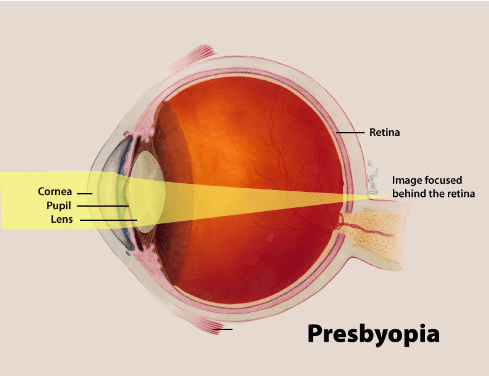Breaking Down One Common Eye Condition

Presbyopia is another somewhat common condition of the eyes, in which the lens of one’s eye (the lens is crystalline in nature), loses its normal state of being flexible. This then results in a perceived difficulty focusing in on objects that are close in proximity.
During childhood, the lens of a typical person’s eye tends to be flexible, and is soft in nature. And because of this flexibility, the eye lens is able to change its shape quite easily. This flexibility then allows a person to focus on objects, regardless of their proximity. Instead, objects that are either close or far away do not present any problems.
As a person ages, however, and nears 40 years or so, the eye lens tends to grow more rigid, losing its earlier state of flexibility. As reason would have it, the reduced flexibility means that the lens of the eye cannot change its shape nearly as easily as it once did. The result is difficulty focusing on objects in close range to the eye, often books, for example. This is presbyopia.
What Causes Presbyopia: Looking at the Eye Condition
Common enough to mean that nearly everyone develops presbyopia, often what happens is that a person who already has been experiencing myopia or hyperopia approaches forty, and feels the effects of a combined condition. The same things happens in patients who deal with astigmatism.
Because myopia, or nearsightedness, and presbyopia appear by definition to contradict each other, statistics show that this combination tends to produce fewer problems for patients.
WHile the results of presbyopia may appear to come on all at once, in truth, the break down and loss of flexibility in the eye of the lens happens gradually, over a period of years, only becoming apparent once a person has hit 40 years of age or shortly thereafter.
Presbyopia is not a disease, and there is no prevention for it as it’s a natural part of the eye going through the aging process, just the same as with other parts of the body.
A Few Tell-Tale Signs of Presbyopia: What to Look For
When you read, pay attention to where you hold your book. If you’re around 40 years old, and you notice that you’re starting to hold the newspaper or your favorite new novel at arm’s length, then this may be worth mentioning to your optometrist.
Similarly, if you experience blurry vision while holding a book at normal reading distance, or if your eyes get tired easily, or if you experience headaches after doing work with objects held up close, then these all may be signs.
Any examination conducted by an optometrist will typically be comprehensive enough to test for this eye condition, though if you are already experiencing the above symptoms, it may be wise to mention this in advance.
Solutions for the eye condition include a prescription for reading glasses or contact lenses. And due to the fact that presbyopia evolves and the flexibility of your eye lens lessens over time, your optometrist may need to change your prescription to account for the condition’s shifting effects.
If you believe you’re experiencing any of the above effects, or if you’re having problems with your vision, contact us today at Beaumont Vision, and schedule a full service eye examination.
[Diagram Via: Bausch]

